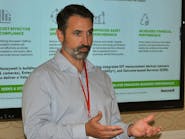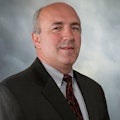Climate-change compliance can drive profitability
Emissions management and climate change have risen to the top of geopolitical and corporate concerns, much the same way that methane rises in the air. A lot of countries have adopted the Paris Agreement from the climate-accord initiative, noted Robert Kester, CTO emissions, Honeywell, who presented during the 2024 Honeywell Users Group Conference this week in Dallas.
“There’s been a growing urgency toward climate change,” said Kester, who noted how Honeywell has undergone a strategic pivot this year. “Customers need a lot more than compliance,” he said. “They need financial outcomes. Emissions data should not just be a cost impact on the business. The data should be used as a catalyst toward enterprise growth to make money for your business.”
Kester identified seven high-value outcomes that the Honeywell emissions platform can enable:
- Increased revenue by preventing product loss,
- Lower maintenance costs through optimized operations and maintenance workflows,
- Increased low-carbon molecule production with continuous leak detection and repair (LDAR) monitoring and SCADA integration,
- Utilization of near real-time emissions inventory data to improve asset reliability and performance,
- Development of custom emissions factors to avoid waste emission charges (WECs),
- Cost-effective achievement of industry sustainability standards, such as environmental, social and governance (ESG) targets, and
- Harnessing of high-fidelity emissions data to enable EU Carbon Border Adjustment Mechanism (CBAM) access, creating a pathway to green pricing premiums.
“Companies are also balancing the fact that they’re public companies and need to make money for shareholders,” explained Kester. “One of the things we’ve been discovering on our own journey is that, on the surface, there’s this tension. There are solutions that deliver net-zero compliance outcomes. But, for these technologies to scale, you need to figure out how to make money.” Emissions coming from a plant are an indication of inefficiency, said Kester. “With solutions that focus on how customers can operate better, we can unlock financial and operational outcomes,” he noted. “Track your emissions against your corporate commitment. Drive compliance and financial value. Detection alone isn’t enough. We want to drive higher-value business outcomes.”
A path to ROI
Honeywell’s emissions-management platform can be utilized to realize not only cost-effective compliance, but improved operations, improved asset performance and increased financial performance.
The platform includes sensing solutions and enterprise-level software to collect data. Signal Scout is a mesh network of solar-powered gas-sensing devices that are Class I, Div. 1-certified. Fixed-mounted Rebellion gas cloud imaging (GCI) cameras capture visible-spectrum and infrared video to look for leaks up to 1,500 meters away. The Honeywell Forge Sustainability+ Emissions Management software platform provides an enterprise-wide understanding of emissions. And E360 expanded-value services enable emissions reporting, system-health monitoring and reporting, emission baselining and monthly key performance indicators (KPIs).
“Signal Scout is an IoT gas-sensing device,” explained Kester. “We combine it with an anemometer to keep track of wind speed and direction. The air carries the molecules to our sensors, and with intelligent analytics we can tell where the leaks are coming from and quantify them.”
Honeywell deployed the Signal Scout camera technology within its own refrigerant facility in Geismar, Louisiana. “We observed that the fingerprints of different types of emissions, such as small fugitive emissions, but, over time, we’d see bigger anomalies,” noted Kester. “In one of our heaters, there was a manual restart process where we’d take out the pilot light because we were flooding it with too much fuel. We were able to change the process to prevent it and remove this emission.”
The Rebellion GCI camera—long-range and mini—makes the same technology available at two price points with maximum distances. It offers continuous visual emissions monitoring in a five-step process that starts with the event, which leads to detection, then analysis, recording and monitoring. “As the gas passes through camera’s field of vision, it is detected and analyzed,” explained Kester. Up to 3 terabytes of data per camera is processed and compressed into a 3 MB file each day.
The camera supports detecting a lot of gases besides methane, including acetone, acetylene, ammonia, butadiene, difluoroethane, ethane, ethylene, ethylene oxide, iso-butane, isobutylene, methanol, natural gas, N-butane, propylene, propylene oxide, toluene and xylene.
Deployments have been made in upstream, midstream and downstream facilities. At one midstream deployment, an Atmos Energy natural gas storage field, “they’re using this as part of their overall ESG strategy,” said Kester. “It’s how we are taking this technology and helping them do even more across their operations.”
A downstream example of particular note was at Honeywell’s own Geismar refrigerant manufacturing facility, where it deployed seven Rebellion cameras—one standard and six mini GCIs. “We were able to decrease emissions at this site more than any other site,” noted Kester. “This was a pretty big deal for us—82% reduction in spurious release quantities.”
Honeywell’s Emissions 360 services program includes concierge LDAR service for fixing the leaks and repairing the equipment; LDAR decarbonization consulting; asset optimization for performance and production; low-carbon supply chain advisory; government grant funding advisory; and green financing.
About the Author
Mike Bacidore
Control Design
Mike Bacidore is chief editor of Control Design and has been an integral part of the Endeavor Business Media editorial team since 2007. Previously, he was editorial director at Hughes Communications and a portfolio manager of the human resources and labor law areas at Wolters Kluwer. Bacidore holds a BA from the University of Illinois and an MBA from Lake Forest Graduate School of Management. He is an award-winning columnist, earning multiple regional and national awards from the American Society of Business Publication Editors. He may be reached at [email protected]

